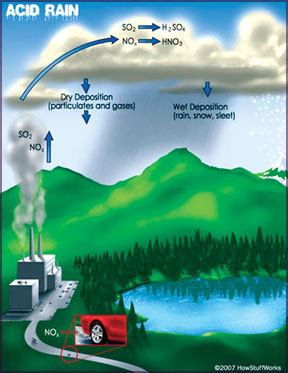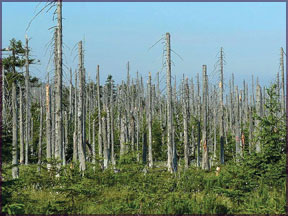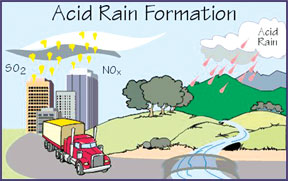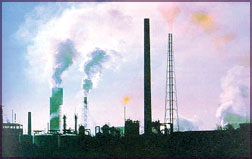 Rains that harm the Earth Rains that harm the Earth
Environmental pollution has been a key concern of the world for a
long time. When we look at the variants of environmental pollution, air
pollution has been one serious outcome of a range of human activities.

However, the harmful effects on the atmosphere are not confined to
the contamination of the air that we breathe. There is an extremely
horrifying outcome called 'acid rain' which can wipe out entire forests
and literally burn whatever gets caught in its path.
As the name implies, this is simply a rain in which the water drops
contain a considerable amount of acidity rather than the neutral water
drops that fall on to the Earth as normal rain. The first recorded acid
rain took place in England in 1852.
Robert Angus Smith, a Scottish chemist, found the relationship
between acid rain and atmospheric pollution. Although acid rain was
discovered in 1852, scientists began widely observing and studying the
phenomenon towards the 1960s.
****
How do acid rains happen?
If you children are familiar with the water cycle, you would know
that rains take place when water on the Earth's surface evaporates
(turns into vapour) and forms clouds.
Thereafter, the little condensed water droplets in clouds collide and
combine to make larger droplets and this is what we see as rain. So, you
may wonder where the addition of acid is taking place in this cycle.
This involves some chemistry. Let us try to understand this, keeping the
complexities to a minimum.

The acids that are commonly found in acid rains are carbonic,
sulfuric and nitric acids. These acids are produced up in the atmosphere
by oxides of carbon, sulfur and nitrogen respectively. So, how do these
compounds exist in the atmosphere? Due to various natural and
human-related factors, these are emitted to the atmosphere, and when
these oxides of carbon, sulfur and nitrogen come into contact with
water, chemical reactions take place and acids are created.
It should be understood that this can happen naturally as well as due
to human activities; the issue has become more challenging during the
recent past. The main natural phenomena (occurrences) that emit
acid-producing gases to the atmosphere are emissions from volcanoes and
those from biological processes that take place on the land, in
wetlands, and in the oceans.
The main causes of acid rain from human sources are electricity
generation, factories and motor vehicles. Coal power plants are one of
the most polluting. The gases can be carried hundreds of kilometres in
the atmosphere before they are converted to acids and deposited. Since
the Industrial Revolution, emissions of sulfur dioxide and nitrogen
oxides to the atmosphere have increased.
In a few instances, pH readings of well below 2.4, which is equal to
the acidity of vinegar have been reported in industrialised areas.
Industrial acid rain is a considerable problem in China, Eastern Europe,
Russia and areas down-wind from them. All these areas burn
sulfur-containing coal to generate heat and electricity.
***
What is an acid?
Over the years, you may have learnt that lime and vinegar are acidic.
Some of you may have even done the 'Litmus Test' in school and observed
that acidic solutions change the colour of blue litmus to red. The real
meaning of an acid lies in its chemical composition.

According to the definition, an acid is a compound which produces a
higher concentration of hydrogen ions (charged electrons) when mixed
with water. The acidity is determined by what is known as the pH value,
which generally ranges from zero to fourteen.
However, when certain super acids are concerned, the range spans from
minus five to fourteen. Water, being neutral, has a pH value of 7. Acids
have pH values of less than 7; the lower the value, the higher the
acidity.
***
Harmful effects
The harmful effects of acid rains span across many segments of nature
such as surface water, soil, forests, animals and human health. When
waterways become acidic due to acid rains, the bio-diversity in them
would reduce, damaging fish and other aquatic creatures.

Where the soil is concerned, high acidity can cause certain microbes
which aid the fertility of the soil to be killed due to their inability
to tolerate such levels. Acid rain can slow the growth of forests and
cause leaves and needles to turn brown and fall off. Acid rain can also
cause damage to certain building materials and historical monuments.
This is because the sulfuric acid in the rain chemically reacts with
the calcium compounds in the stones such as limestone, sandstone, marble
and granite to create gypsum, which then peels off. One important
monument which has faced this challenge is the famous Taj Mahal.
Compiled by Aravinda Dassanayake |
